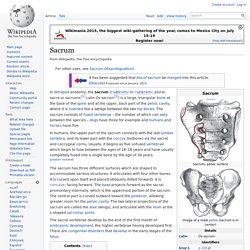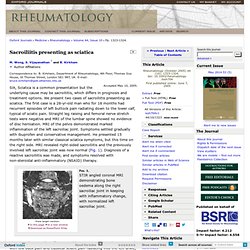

Hip bone. Sacrum. The sacral vertebrae develop by the end of the first month of embryonic development, the higher vertebrae having developed first.

There are congenital disorders that develop in the early stages of the fetus. Name[edit] English sacrum was introduced as a technical term in anatomy in the mid-18th century, as a shortening of the Late Latin name os sacrum "sacred bone", itself a translation of Greek ἱερόν ὀστέον, the term found in the writings of Galen.[3][3][4][5][6][7][8] Prior to the adoption of sacrum, the bone was also called holy bone in English,[9] paralleling German heiliges Bein or Heiligenbein (alongside Kreuzbein[10]) and Dutch heiligbeen.[9][11][12] The origin of Galen's term is unclear. Structure[edit] Sacroiliac joint. Structure[edit] Articulations of pelvis.

Anterior view. Articulations of pelvis. Posterior view. Sacroiliac joints are paired C-shaped or L-shaped joints capable of a small amount of movement[2] (2–18 degrees, which is debatable at this time) that are formed between the articular surfaces of the sacrum and the ilium bones. As we age the characteristics of the sacroiliac joint change.[4] The joint's surfaces are flat or planar in early life but as we start walking, the sacroiliac joint surfaces develop distinct angular orientations and lose their planar or flat topography.[2] They also develop an elevated ridge along the ilial surface and a depression along the sacral surface.[5] The ridge and corresponding depression, along with the very strong ligaments, increase the sacroiliac joints' stability and makes dislocations very rare.
Ligaments[edit] Sacroiliitis. In medicine, sacroiliitis is an inflammation of the sacroiliac joint.

Sacroiliitis is a feature of spondylarthropathies (such as ankylosing spondylitis, psoriatic arthritis, reactive arthritis or arthritis related to inflammatory bowel diseases including ulcerative colitis or Crohn's disease). Sacroiliitis Is Often Missed In Diagnosing Back Pain by Dr. David Lipschitz on Creators. More than 80 percent of Americans have back pain at some point in their lives.

For some, the pain is caused by inflammation of the sacroiliac joint that attaches the sacrum (the lowest part of the spine) to the pelvis. Often this condition is missed or inappropriately treated. The disease is called sacroiliitis, and in people under age 60 an underlying medical condition is often present. These include inflammatory bowel disease (ulcerative colitis and Crohn's disease), psoriasis and a condition called ankylosing spondylitis. Sacroiliitis can occur as a complication of infections in the heart, skin, joints or muscle. In a typical patient, the symptoms can develop very suddenly with pain that is usually localized to one side of the back. All About Sacroiliitis. The term sacroiliitis is used to describe any inflammation in the sacroiliac joint, which is located on either side of the sacrum (lower spine) that connects to the iliac bone in the hip.

See Sacroiliac Joint Anatomy Sacroiliitis is often found as part of a feature of inflammatory conditions of the spinal column. As a group, these conditions and diseases are termed a "spondyloarthropathy" and include conditions such as ankylosing spondylitis, psoriatic arthritis, and reactive arthritis, among others. Sacroiliitis may also be a component of other types of arthritis, such as ulcerative colitis, Crohn’s disease, or osteoarthritis. Sacroiliitis Treatment. The specific sacroiliitis treatments will be determined primarily by the type and severity of the patient’s symptoms, and the underlying cause of the sacroiliitis.

See also Treatment Options for Sacroiliac Joint Dysfunction Non-Surgical Treatments for Sacroiliitis There is a wide range of nonsurgical options available. Most patients find that a combination of two or more of the following nonsurgical treatments can be effective in managing their symptoms: Rest A short period of rest may help calm the inflamed sacroiliac joints. Heat and/or ice Warmth or cold applied to the area will provide local pain relief.
See also Heat and Cold Therapy Sleep position Changing one's sleep position can help alleviate pain while sleeping and at waking. See also Mattresses and Sleep Positions for Each Back Pain Diagnosis Article continues below See also Sacroiliac (SI) Joint Exercises for Sciatic Pain Other Sacroiliitis Treatments For related information, see also Sacroiliac Joint Dysfunction (SI Joint Pain). Sacroiliitis presenting as sciatica. + Author Affiliations Correspondence to: B.

Kirkham, Department of Rheumatology, 4th Floor, Thomas Guy House, St Thomas Street, London SE1 9RT, UK. E-mail: bruce.kirkham@gstt.sthames.nhs.uk Accepted May 10, 2005. Sir, Sciatica is a common presentation but the underlying cause may be sacroiliitis, which differs in prognosis and treatment options. We present two cases of sacroiliitis presenting as sciatica. Fig. 1. STIR angled coronal MRI demonstrating bone oedema along the right sacroiliac joint in keeping with inflammatory change, with normalized left sacroiliac joint. The second case is that of a 29-yr-old sports consultant who presented with low back pain and classical sciatic pain radiating into the left ankle, and a positive straight leg raising test.